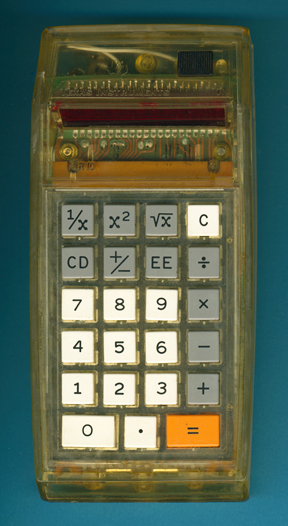
DATAMATH CALCULATOR MUSEUM
 |
DATAMATH CALCULATOR MUSEUM |
Texas Instruments SR-10 Version 1 (Clear-Case Prototype)
| Date of introduction: | (November 1973) | Display technology: | LED modules + lens |
| New price: | ($149.95) | Display size: | 8 + 2 |
| Size: | 6.3" x 3.1" x
1.5" 158 x 78 x 38 mm3 |
||
| Weight: | 9.2 ounces, 262 grams | Serial No: | (381099) |
| Batteries: | 3*AA NiCd | Date of manufacture: | wk 48 year 1973 |
| AC-Adapter: | AC9200, AC9130 | Origin of manufacture: | USA |
| Precision: | 8 | Integrated circuits: | TMS0120, 2*SN75493, 2*SN27423 |
| Logic: | Chain | Displays: | DIS115F (12*DISXXX) |
| Memories: | |||
| Program steps: | Courtesy of: | Joerg Woerner | |
| Download manuals: | |

![]()
 The
SR-10 was introduced only few month after TI's first calculator, the famous Datamath
or TI-2500. Today we wouldn't call it a Scientific calculator, but it used the scientific
notation on the display. Texas Instruments targeted the slide rules, guess what
the abbreviation "SR" in the designation stands for.
The
SR-10 was introduced only few month after TI's first calculator, the famous Datamath
or TI-2500. Today we wouldn't call it a Scientific calculator, but it used the scientific
notation on the display. Texas Instruments targeted the slide rules, guess what
the abbreviation "SR" in the designation stands for.
![]() The first series of the SR-10 lacked of the poor readability
of the TIL-360
display known from the Datamath calculator.
The first series of the SR-10 lacked of the poor readability
of the TIL-360
display known from the Datamath calculator.
![]() Texas
Instruments experimented with different solutions and created some prototypes
with lenses attached to the 6-digit LED-modules.
Texas
Instruments experimented with different solutions and created some prototypes
with lenses attached to the 6-digit LED-modules.
 This SR-10 Clear-Case Prototype
manufactured in November 1973 used different LED-modules with an additional magnification lens to enhance readability of the display. We assume that engineers at Texas Instruments decided to use transparent plastic material with the original mold of the first generation SR-10 to verify clearances of the new display with the housing.
Compare this prototype with the later SR-10 Version 2.
This SR-10 Clear-Case Prototype
manufactured in November 1973 used different LED-modules with an additional magnification lens to enhance readability of the display. We assume that engineers at Texas Instruments decided to use transparent plastic material with the original mold of the first generation SR-10 to verify clearances of the new display with the housing.
Compare this prototype with the later SR-10 Version 2.
 The
SR-10 makes use of the TMS0120 single-chip calculator circuit derived from the TMS1802,
better known as first "calculator-on-a-chip".
The remaining components found inside an early SR-10 are known from the
Datamath, too. The two plus two display-drivers
SN75493 and
SN27423 (SN75494)
located in the featured SR-10 are improvements of the original
SN75491/SN75492
chips introduced with the TMS1802 but allow for operation at lower voltages. The
lower half of the printed circuit board (PCB) contains mainly a discrete power converter to generate the three different
supplies voltages used with the calculator and the generation of the clock
signal for the TMS0120 chip.
The
SR-10 makes use of the TMS0120 single-chip calculator circuit derived from the TMS1802,
better known as first "calculator-on-a-chip".
The remaining components found inside an early SR-10 are known from the
Datamath, too. The two plus two display-drivers
SN75493 and
SN27423 (SN75494)
located in the featured SR-10 are improvements of the original
SN75491/SN75492
chips introduced with the TMS1802 but allow for operation at lower voltages. The
lower half of the printed circuit board (PCB) contains mainly a discrete power converter to generate the three different
supplies voltages used with the calculator and the generation of the clock
signal for the TMS0120 chip.
The
Klixon™ type keyboard looks
very similar to the Datamath calculator with some additional keys placed in the
upper line. Later calculators like the SR-11 changed the
style of keys but the extreme wedge-style of the housing consists nearly 2 years.
Last model in the wedge design was the SR-16. Don't
miss to explore the huge wedge calculators SR-20
and SR-22.
If you have additions to the above article please email: joerg@datamath.org.
© Joerg Woerner, November 18, 2018. No reprints without written permission.